With photo and video journalism from ‘Washington Rise with Standing Rock’ in Olympia, WA
Earth-Feather Sovereign and her five year-old daughter Rainbow visited my home on March 6, 2017, so I could learn more about Earth-Feather’s life’s work, and about the Washington Rise with Standing Rock event in Olympia, organized by the LOK CHANTE Legal Fund. Rainbow played with toys while her mom and I had this conversation (transcribed below). The talk is followed by photos and video clips of the Washington Rise with Standing Rock gathering that took place Saturday, March 11, 2017. There are links with some of the photos to learn more about Water Protecting and Indigenous Resistance happening in Washington State.
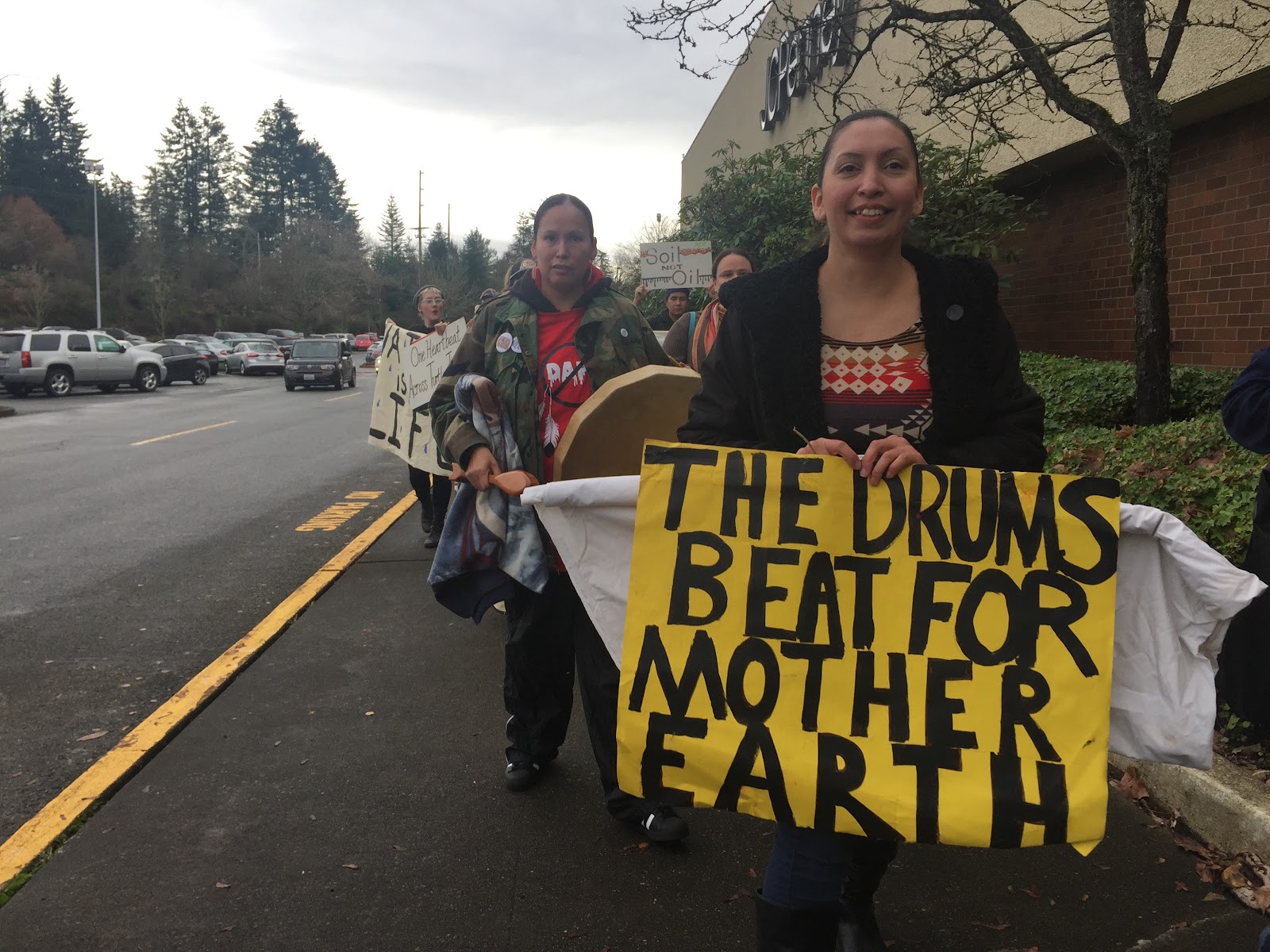
Earth-Feather Sovereign smiles walking through a mall parking lot, while holding a yellow hand-painted sign that says, “THE DRUMS BEAT FOR MOTHER EARTH.” She is participating in a march, and her sister Morningstar is just behind her, with other community members behind them. In the distance a sign is held up that says “soil, not oil.”
Earth-Feather: My name is Earth-Feather Sovereign. I’m a member of the Colville Confederated Tribes here in Washington State. Traditionally when Native people introduce ourselves, we usually introduce our parents. My father is Ernest Clark, he was a former Councilman for our Tribe. My Mother is Deanna Marcellay, she passed away a couple years ago. I am also a descendant of Chiefs and Matriarchs. The Colville Tribe is made up of thirteen Bands, and of those Bands, I am a member of the Okanogan Band, the Sanpoil Band and Nespelem Band. Originally the Nespelem and the Sanpoil Band were part of the Okanogan Band of the Northern and Southern regions. I say Northern and Southern regions because when the government divided the United States and Canada, they put their border between our People. So, on my Mother’s side, I’m a descendant of Chief Antoine, he’s one of the last Chiefs of our tribe. On my paternal side, I’m a descendant of Chief James and Chief Nespelem. Nespelem George, his Mother was one of the last Matriarchs. Because our Tribe, we were Matriarchal before the Europeans came, we really didn’t have Chiefs, we had Spokes Peoples, Spokesmen. But when the Europeans came they just pretty much considered them (the men) chiefs and leaders of our People when it was actually the Women who led.
When some people think of Matriarchs they get it confused with patriarchal power. Matriarchs are like Mother clans. They think of the best interest of their People, with Love and Compassion, not power. One of the last Matriarchs of our people was Que-Petsa, and she also helped to advocate between our People with some of the first settlers who came through, Lewis & Clark. So, in saying all that, that history that I have, it’s always been my passion to advocate for the best interest of my People.
Lisa: What’s your history with activism, and is that a word you are comfortable with? May I call you an activist? (in conversation after this interview, Earth-Feather identified as an Awakener, see video clip #4)
Earth-Feather: When I think of activism, I think of Love in Action. Because I love my Indigenous People, I love all People, all People of all the four colors. Cuz, you know, we all have Indigenous roots somewhere. Even the Europeans have Indigenous roots, where they used to be able to use their plants and their medicines and be close to Mother Earth. One of the things my mom told me is that “Love is work in action.” I grew up with my Mother. She was a single Mother with just me and my sister, Morningstar. When I think of starting my story I usually start with my Mother’s story or even her Mother’s Mother’s story.
My Mother, she grew up in a dysfunctional home with drugs and alcohol, and domestic violence. She had fourteen brothers and sisters. She spent ten years at the Tribal boarding school, where she was raised by Catholic nuns and priests. And she endured abuse while attending the boarding school. That is some of the reason why our people are struggling today. Because a lot of our people grew up in the boarding schools. They learned a lot of toxic behaviors, and they didn’t have their parents around to teach them our traditional ways of how a family should be. So, they took some of those behaviors of being physically abused and being sexually abused, and they either brought that home and became perpetrators themselves or ended up in relationships where there was abuse because it felt normal for them. My mom, after boarding school, she was able to go to New Mexico, where she went to art school. That was during her high school years. And then when she came back home, she met a young man and she became pregnant at a young age of 18 and she had a son. His name was Sean. She was a young Mother and was struggling to make ends meet. Unfortunately, he only lived to be five years old. He was hit by a car. That was really hard for my Mom. She didn’t really know how to be a Mother, because her biological Mother passed away when she was like, two. And her stepmother wasn’t really a Mother to her. And then part of her life was in the boarding school, so, she didn’t really know how to be a Mother. She said to me that she didn’t know what real Love was until she had me and my Sister.

A photo taken of a newspaper with 2 photos of Native Women and children, on the lower left is Lucy George, wife of Chief Nespelem George and the photo dates to the 1930s. The photo above on the right has a caption that reads “Deanna M Clark, an opponent of the mining agreement, with her children MorningStar, 5, left and Earth-Feather, 2, in front of their home. The words “COLVILLE DEAL” top the newsprint.
Around the time my Mom was grieving over the death of her son, she decided to go back to school. She went to Evergreen, to get her BA in Native American studies. And she learned about the American Indian Movement. So her and her sister decided to go that way. I would say this was maybe 1975. And my Mom, she met Leonard Crowdog. And my Mom wanted to vision quest, because she felt pretty lost. She heard that people were going up in the mountain and getting ready to sundance, and preparing for other ceremonies. So, she decided to go up on the mountain. She decided to go for four days and four nights. Leonard said that usually only the men would go four days and four nights.
Usually the Women only went up for one day and one night. But my Mom, she had a desire to be up there as long as the men. Every day Leonard would see her, or bring her down from the mountain. She’d be in a sweat lodge and he would ask her, “Well, what did you see?” And my Mom said that she seen a lot of Mother Earth’s creatures, the insects, the animals. She seen the deer, she said she seen a male and female cougar. She said she seen eagles, that would always come to visit her. I think it was towards her 3rd or 4th night, there was a thunderstorm. The thunder beings were coming to visit her. It rained, it thundered. And my Mom said she seen a vision in the clouds. Then, when Leonard came to see her, he was grateful that she was still standing strong. He said a lot of the men, they got chased down that mountain, from a warrior spirit. (Laughter)
My Mom managed to stay up there! She said she didn’t see the warrior spirit, but she seen the thunder beings. Before that, Leonard said there used to be a heaviness in that area. Cuz that area was closeby to where they had Wounded Knee. So there was a heaviness. A sadness. He said after she was up there like that, and the thunder beings came, Leonard said it was like there was a Lightness. To everything. Like, her being up there helped Heal the place. My Mom said that while she was up there that she prayed to have more children, and she prayed to the morningstar because she felt good every morning when she’d see the morningstar. That’s why my sister, her name is Morningstar. She remembers how close she felt to the Mother Earth, and that’s why my name is Earth. That represents the Mother Earth, and Feather that represents the eagle. We call Mother Earth our mother because she takes care of us like a Mother would. She provides the food for us. Even the animals, they eat the plants she provides, and we eat the animals. You know? She has the water through her veins, and we drink the water. And most of our body is made of water. Even when we’re inside our own mothers, we are surrounded by a water substance.
And so when we come into this world, it’s the Mother Earth that takes care of us, with our own Mothers. My Mom said she named me after the eagle, and the eagle is significant to our people because they bring our prayers up to the creator. And so that’s why when we have our ceremonies, we use the eagle feathers when we smudge. Cuz even when we Smudge, we Pray. My Mom says the eagle is really significant too because it flies the highest and sees the farthest of all the birds. So, I think that’s really neat.
Shortly after my Mom’s vision quest, she went from jumping into a sweat to going into a peyote ceremony, then going into a sundance. So she was really spiritually strong around that time. During her sundance is where she met Russell Means, and I’d say about maybe 12 months later, my sister was born. (laughter). My mom was with him during the AIM (American Indian Movement) trials. There was a lot going on back then. I believe that some things come full circle, sometimes we have to relive things to help us learn something we didn’t learn before. Like with the Sacred Stone camp, everything was beautiful at the beginning. Everybody seemed united. But towards the end, there was a lot of rumors going around, a lot of distrust. And, even, they were saying that the government was trying to come into the camp and look for bodies. That was scary, that reminded me of AIM with Anna Mae, and all of the distrust. So, my Mom, she had to get away from that. Her Baby was more important than dealing with all that. My Mom, she wanted a different life, you know, for her Daughter.
Lisa: How much older is Morningstar than you?
Earth-Feather: She’s 2 ½ years older. And so, when Morningstar was a baby, my mom met my father. My father was the youngest man on Tribal Council. They got married, and they had me. Their relationship didn’t last that long. I think it takes a really strong man to be compatible with a really strong Woman. (laughter) My Mom had too much strength for the both of them. (laughter). But my Mom would tell me stories about Our People. My Great Grandma Christine, she lived to be 104, and she passed away when I was 14. We went to visit her quite a bit. I went from living on my reservation til i was almost four, then we moved to Portland, OR, then we came up to Olympia. So I was able to go to school at WaHeLut (Indian School) when I was an elementary school student. Then we went back to my reservation, even spent some time in Yakama. Then back down to Portland. Then to Spokane. I even travelled down to California and Arizona. And now I’m back up here to Olympia. When we lived in Portland my mom was part of the Big Mountain movement with, I believe it was the Hopi Tribe. They were trying to mine their sacred Mountain. So, my Mom, she would always bring us to meetings about that. When she went to a rally or a march, she usually kept us home, then we would see it on the news. But then when my Mom would go speak with senators, she would bring me along. I was my Mom’s baby. I shadowed her everywhere. I was able to see her in action. See how she talked with people.
Lisa: I’m really liking learning about you, learning about your mom, she sounds amazing! I want to learn more about the Big Mountain resistance, I don’t know anything about that. (Read about the history of Big Mountain/Black Mesa and Peabody Coal here http://www.aics.org/BM/bm.html)
So, thank you! So, what brought you back to Olympia? Is your mom and sister around?
Earth-Feather: My sister is around. My Mom, in about 2010, she developed breast cancer. She was in remission, and when she was in remission I spent time in Arizona. Then I came back, and cancer came back, in her blood. And then in her bones. So, she passed away in 2015. We buried her back on our reservation.
Lisa: Where is the Reservation?
Earth-Feather: Colville Reservation. It’s like the middle, Northeastern part of Washington state. It’s the second biggest Tribe in Washington state. The largest Tribe is Yakama Nation.
Lisa: Thank you for sharing all this with me. I’m learning so much! And you are pointing me in directions to learn more about the history of where I live. So, thank you.
Earth-Feather: Yeah, Washington state, it has 29 federally recognized Tribes and about 32, so about 3 of them, they are not recognized. They were either never recognized, like the Duwamish, or they lost their federal recognition. WE recognize them, just the government doesn’t want to recognize them. Our Tribe was one of the Tribes who almost lost their federal recognition. The government offered to pay us a lot of money if we would fully assimilate.
But, my Mom, and some of her friends, that I still look up to today, like Yvonne Swan-Wanrow, along with a few other strong Women, they were telling our people, NO - we can’t give up our sovereignty. And around that time too, they were trying to mine. When I was younger they were trying to mine on our land. I think the mount was called Mount Tolman, my mom tried to spearhead that with our Tribe to help educate others. The funniest thing is, my dad, he was on Tribal Council, and he was FOR mining. And my mom was against it. She campaigned against him. (laughter)
Lisa: Wow. Your mom’s awesome.
Earth-Feather: That shows how much she was AGAINST mining and FOR our People. Now that I think back and I look at it, I mean… How can he be for mining when his own Daughter was named after the Mother Earth? Right? (laughter) I think that’s comical. (laughter)
Lisa: And so, when did you start doing organizing?
Earth-Feather: Well. Before my Mom passed away, she had a vision of all these programs that she wanted to start. She was on her way of beginning all these programs, that would help Heal the Women and Children. So, when she passed away, I wanted to continue my education, and pick up where she left off. And get her programs started. So, I started going back to school.
Since I was 5 years old, I’ve wanted to be an attorney. I’m a libra and I remember my Mom told me libras make good attorneys, she sat down and explained to me what they do, and I was like, “Oh. Well I want to be an attorney!” Then I remember being 16 and sitting down with Russell Means, and he was asking me and my sister, “So what do you guys want to do with your lives?” And I told him, “well, ever since I was little I’ve wanted to be an attorney.” He was like, “an attorney?!? Oh. Well. If you were an attorney I would never hire you.” And I was like, “Oh. And why is that?” He’s like, “Attorneys are almost like the military. You go against your People.” I told him I’m not trying to go against my People. I’m trying to advocate for my People. I’m trying to HELP my People. And then, come to find out, that his Daughter who is about my age, she’s an attorney. (laughter) I think she heads the Lakota Law Project. So I’m hoping I had some influence there. (laughter).
But my Mom, she moved over this way because she wanted to get her masters in Tribal governance. Because she wanted to start all these programs. But then she got sick and she wasn’t able to complete the program. And so, now I’m attending college. I’m trying to get that Tribal governance degree, and then onto law school.
Lisa: Nice! And, you are a Mom.
Earth-Feather: Yes. I’m a Mom of four children. My oldest, his name is Aztec, and he’s 17. People say the word “Aztec” means “of the People,” or “for the People.” I have a son, Sky, he’s 15. His real name is Sky-Lu. Sky-Lu (Sk’ae_L’oo) in the Okanogan language, that means “for the People.” And my daughter Katiri, she’s 9, and she’s named after Saint Kateri, she was a(n Indigenous) healer, in the Catholic faith. She really helped the People. I spell my daughter’s name a little bit differently than the Saint Kateri. Because my daughter, she’s her own saint.
And then my youngest daughter, her name is Rainbow. And my Great Grandma, part of her medicine was the rainbow; that’s like all nature’s powers together. So that’s my way of naming my daughter after her Great, Great Grandma. Also, when I think of the rainbow, I’ve always heard prophecies. And I believe that our prophecies are true, that one day, our People of four colors and of all Nations could come together and Heal.
Lisa: That’s hopeful, I love it.
Earth-Feather: I have one child for every season. Aztec, he was born in the summer. Sky was born in the fall. Kateri was born in the spring and then, my Rainbow was born in the winter.
Some people too, they wonder about my last name. Because my last name is not my father’s name, and I’m not married. Recently, I became divorced, August of last year. I’ve learned that I can change my last name, on my documents, on the court documents. And so, I made up my own last name. Sovereign. I wrote an article about it, and Last Real Indians, they published it. (Please read that article at http://lastrealindians.com/whats-in-a-last-name-by-earth-feather-sovereign/)
Back during the Idle No More movement, my Mom was still here, we were still talking about the programs that we wanted to start. We thought that we should start one of the programs of getting our Indigenous Women together. And from there we would be able to help bring awareness of all the things that are going on with our people. It came to mind to start a group called the Indigenous Women’s Warrior Society. I started this group because, being Women, I believe that we are at the bottom of the totem pole, so to speak. But by being at the bottom, we are able to uplift others. And because our Women, statistically 2 out of 3 Indigenous Women are victims of sexual assault. That could be my mother, my sister, my daughter. And those are only the reported cases. Our Women who know they were sexually assaulted. I was sexually active at a young age. People would consider that maybe I was promiscuous, when in reality, I was being raped. Cuz I was underage. Also one out of three Native American Women experiences domestic violence. And again, those are only the Women who realize they are being abused. I didn’t know I was being abused, because I didn’t get the crap knocked outta me. But I was being abused. There is abuse that happens physically, emotionally, mentally. Even spiritually and financially.
And our Women are becoming, you know, MISSING. In Canada there are over a thousand missing and murdered Indigenous Women, cases that are unsolved. And in the United States, there’s no number. There’s no number yet. I believe the University of Washington is trying to gather statistics on that. Also, statistically, our People are being murdered by the police more than any other race. We just don’t hear about it as much. I believe all this is active continued genocide. Because, if there’s no more Indigenous Women, then there’s no way to continue our lineage. If there is no lineage then the government could get rid of our Tribes and kick us off our reservations. All of this is related. Some of our Women are missing because some of them are growing up in foster care. When those girls turn 18, they don’t really have nowhere to go. So a part of their survival is, that they go and sell their bodies. Or, somebody steals them and sells their bodies to some of these man camps, these oil men camps. So I believe, if you were to follow the trail of all these men camps, that you might be able to find some of our Women. That’s why I believe our Women are at the bottom of the totem pole, and I believe that once the healing comes to our Indigenous Women, that when we start to heal from the bottom… Then the healing will work it’s way up. It’s like, when We rise, all People rise.
So I started reaching out to Women for the Indigenous Women’s Warrior Society. We have Women from North America, South America. We have Women from Africa, Australia, New Zealand, Asia, and - I forgot the European Tribe… But yeah! (laughter) Women from all over. It’s not only Women who have their own grassroots, it’s Women who are trying to get back to their Indigenous roots. Women who are trying to bring Healing to other People and to their families. One of my first actions was a flash mob Round Dance at the (Olympia) mall and a march downtown. I collaborated with Idle No More Olympia. It’s not only an issue at Standing Rock, of No DAPL or the XL pipeline… We have our own issues here in Washington state. We have coal trains coming through, coal going out in the ships, toward China, polluting our oceans. They want to start fracking in our oceans and on our land. They not only want to run oil pipelines but gas pipelines, through and by our Tribes. If you look up that map (of WA), we have A LOT of little reservations everywhere. And it doesn’t only affect the Indigenous people here in Washington state, it’ll affect all of Us. Because, living in the Northwest, you know, we cherish our Water. The environment we have here is different than in a lot of areas. We have beautiful greenery of trees and plants, our wild animals that everybody here loves, doing outdoor activities... It will affect everything around here, and our territory is so beautiful.
So, that brings me to another event that is happening, Saturday March 11th(2017), because there is a global call to action on March 10th. I’m collaborating with some of the people from the Seattle No DAPL, including Matt Remle (Lakota), Millie Kennedy (Tsimshian) and Rachel Heaton (Muckleshoot), and they requested that we do a march here in Olympia. Their event is on the 10th, and the Olympia event is on the 11th.
As I was putting the event together, I didn’t want it to just stand for Olympia. I think I made that mistake the last time I was doing my march. Because it kind of does disappoint me that everybody likes to gather in Seattle, and I see why, the community is very large. Not many people have transportation to come down here to Olympia. I feel like Olympia represents the whole state of Washington. This is where our government leaders are, this is where they make and change laws. And we can’t only be out there, yelling around, saying “we don’t agree with this.” Or just stand there saying “I’m here to protect Mother Earth.” We need to follow up by changing the laws. And making people be held accountable for their disregard of Indigenous environmental rights. And thinking they could just throw a few thousand dollars down after they destroy our sacred sites. You know, they need to be held accountable, and that can’t happen anymore. And it’s really sad that president trump could just sign an executive order and try to abolish the EPA, with just the swipe of a pen. Putting pipelines, approving the DAPL, the keystone pipeline again… So like I said, there’s all these other companies, that are trying to come in here to Washington state. So we need to stand up to the government. Because what happened over in North Dakota could just as easily happen here. So I am gathering Tribal leaders from the different Tribes, because Arvol Looking Horse said that the 7th fires were lit. Now it’s time for us to bring that flame and reignite it in our own home territories. We need to bring awareness. So at my event, I’m hoping that these Tribal Leaders will let us know what’s going on in their home territories. And let us know how We could Help. And I really hope the event turns out well. We’ll also have my friend Star Nayea, she will be performing two of her new songs she just wrote about Standing Rock.
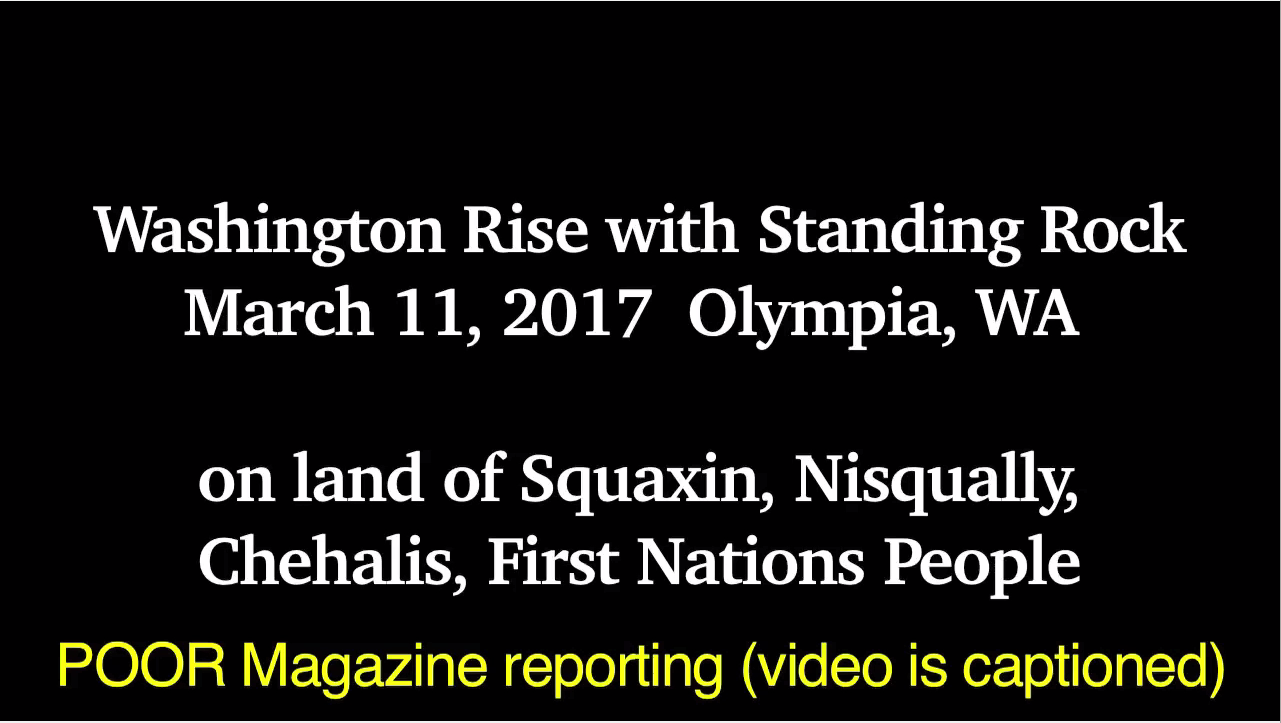
(Click image for video link)
Description: It is raining, and after the water blessing, prayers and songs at Heritage Park, grassroots and Indigenous community members lead a march toward the legislative building. It is raining, and a de-escalation safety team (in orange vests) support the taking of the streets.

(Click image for video link)
Description: The rain has stopped and the march continues through downtown Olympia, past banks and businesses, on their way to the state capitol’s legislative building.

(Click image for video link)
Description: The sun breaks from the clouds as The People marching arrive at the capitol.
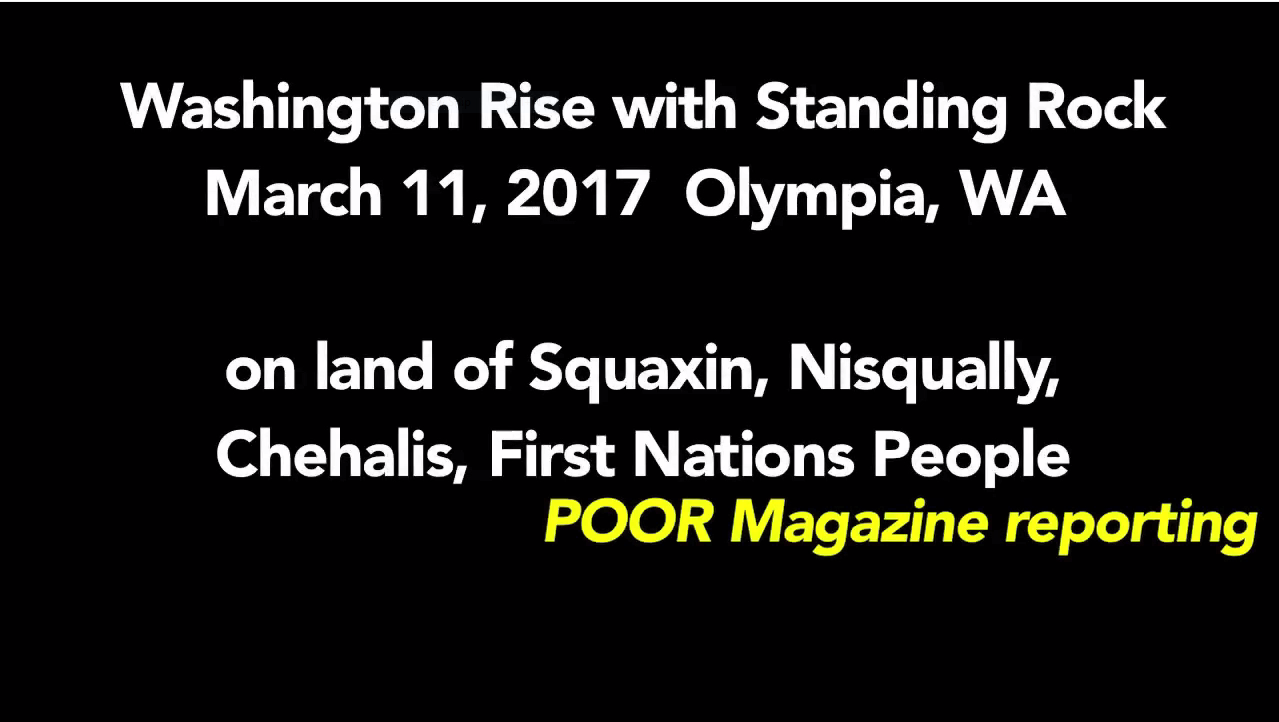
(Click image for video link)
Description: Activator, Earth-Feather Sovereign, shares at the microphone to the many people gathered on the steps of the legislative building. She is joined by her daughters Rainbow and Katiri.

Description:
Marles Black Bird and Morningstar Means are marching on the wet streets of downtown Olympia, right in front of the “Bank of America,” holding the light blue Tribal flag of the Standing Rock Sioux Tribe. Marles holds a blow horn and Earth-Feather is behind her and many other marchers. Please watch this video statement of Marles Black Bird https://www.youtube.com/watch?v=-lGrrnADBPM

Description:
The march continues past the “Bank of America,” front and center are Nisqually Canoe Youth, smiling and drumming behind them are Matt Remle of Last Real Indians and other Indigenous Water Protectors and community members. There is a tall person wearing a hat with their fist in the air. Signs in the background read “Water is Life” and DIVEST. Please read http://lastrealindians.com/divest-now-joint-statement-regarding-the-next-stage-in-the-fight-against-dakota-access-pipeline-by-gyasi-ross-matt-remle/ and http://lastrealindians.com/guide-to-divestment-by-rachel-heaton/ by Rachel Heaton to learn about the Divestment Movement and the success in Seattle.
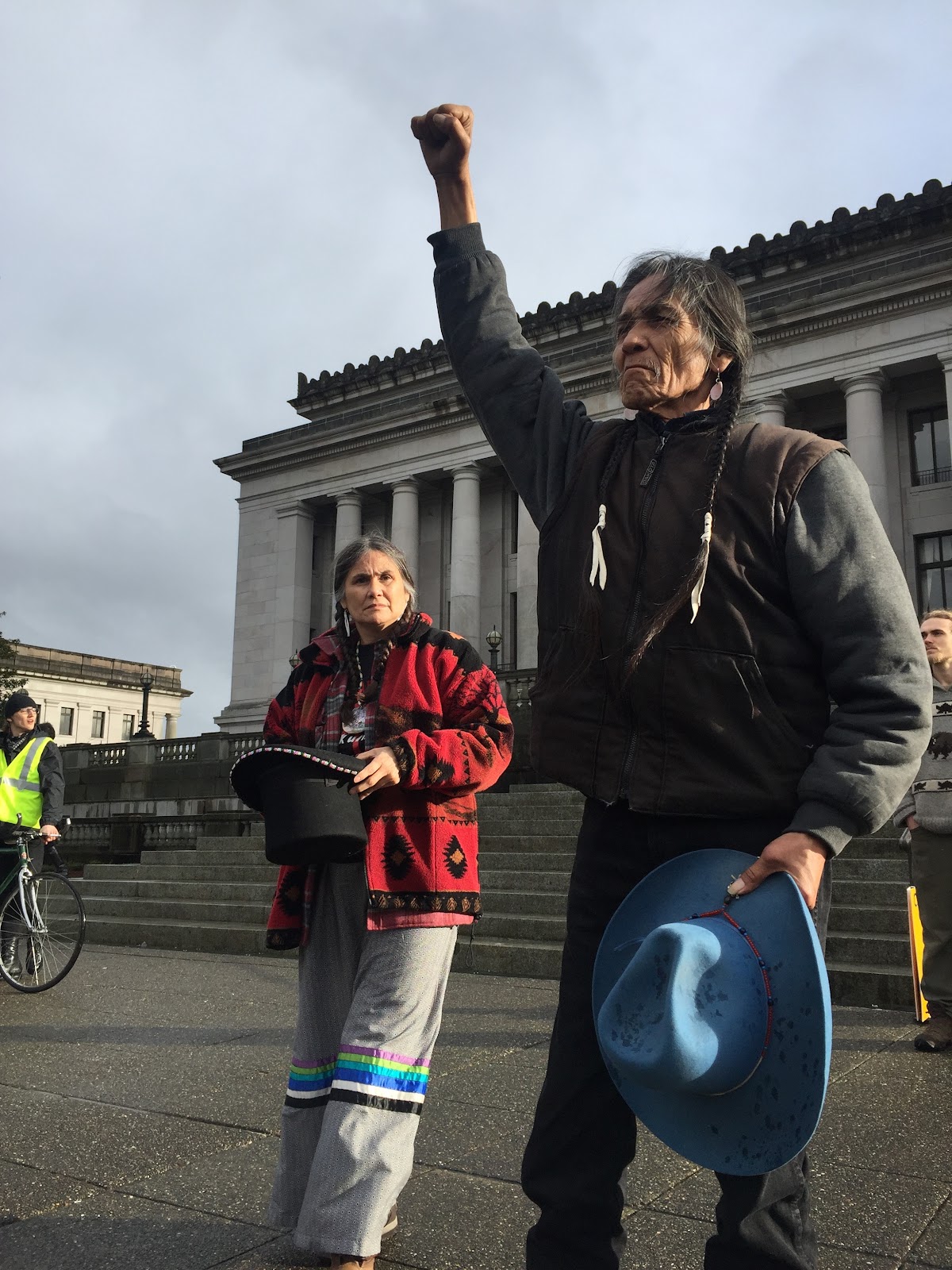
Description:
As the march arrives to the Washington state capitol grounds, Indigenous Elders Shelly Boyd (Colville Confederate Tribes) and Larry Kenoras (Okanogan BC) greet the crowd. Larry Kenoras wears long braids, holds a blue hat in his hand with his right fist raised powerfully. The sun is shining on their faces. Read more and about Shelly Boyd’s life’s work dedicated to the revitalisation of Salish languages and support the The Inchelium Language House here http://www.incheliumlanguagehouse.com/our-home
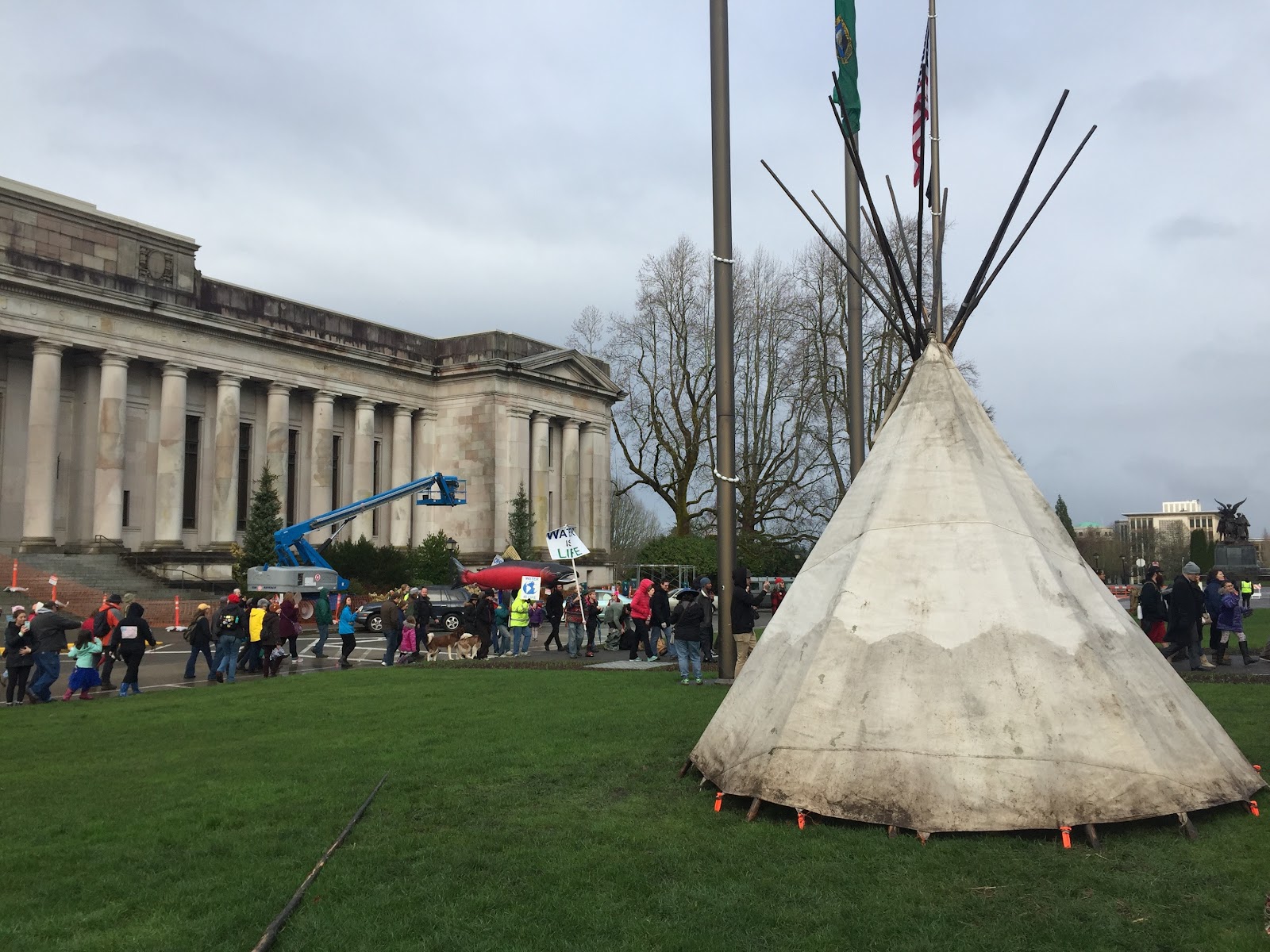
Description:
People circle the state capitol grounds, making their way to the front of the legislative building, at the center of their walk is a huge Teepee that has been raised on the grass prominently next to the US flag and the state of Washington flag. There is a blue construction crane in the background. There are at least 150 people that have marched.

Description:
The People make their way onto the steps of the legislative building, with Indigenous community members at the top of the steps, and many People on each side. This is a huge building, with massive Roman style columns. At the top of the stairs are outstretched arms in gratitude and prayer, including those of Earth-Feather Sovereign, who is wearing a black sweater with blue on the front. There are many raised fists and hands. To the left is a huge red Salmon that was created and carried during the entire march, it is several feet long. Learn more about the history of the Broken Medicine Creek Treaty and the Struggle to fish salmon by watching the movie As Long as the Rivers Run by Carol Burns 1971 here https://archive.org/details/AsLongAsTheRiversRun

Description:
Indigenous Elder, Elaine Sutterlict-McCloud (Chehalis) is wearing a clear rain jacket and a maroon sash that says “WATER PROTECTOR” on it, she’s holding a microphone. She is wearing sunglasses and addressing the crowd. Read Honoring Our Elders: Elaine Sutterlict McCloud in the Chehalis Tribal Newspaper here https://www.chehalistribe.org/newsletter/pdf/2009-12.pdf

Description:
Puyallup Tribal Elder, and long time activist for Indian fishing rights, Ramona Bennett is standing with James Rideout and Jesse Nightwalker, and she has just passed the microphone to Water Protector, Roxy Murray, who says, “there are seagulls falling from the sky in the port of Tacoma…” Learn more about Ramona Bennett at http://depts.washington.edu/civilr/bennett.htm

Description:
The sun is going down, and ten members of the Quinalt Indian Nation are standing before the crowd, Five youth and five adults. Two Spirit and Quinalt Nation Vice President, Tyson Elliot, stands to the far right, with their right hand to their chest, and left hand holding the microphone. Please read “Shared Waters, Shared Values” Quinault Nation Battles Proposed Oil Facilities in Last Real Indians at http://lastrealindians.com/shared-waters-shared-values-quinault-nation-battles-proposed-oil-facilities/
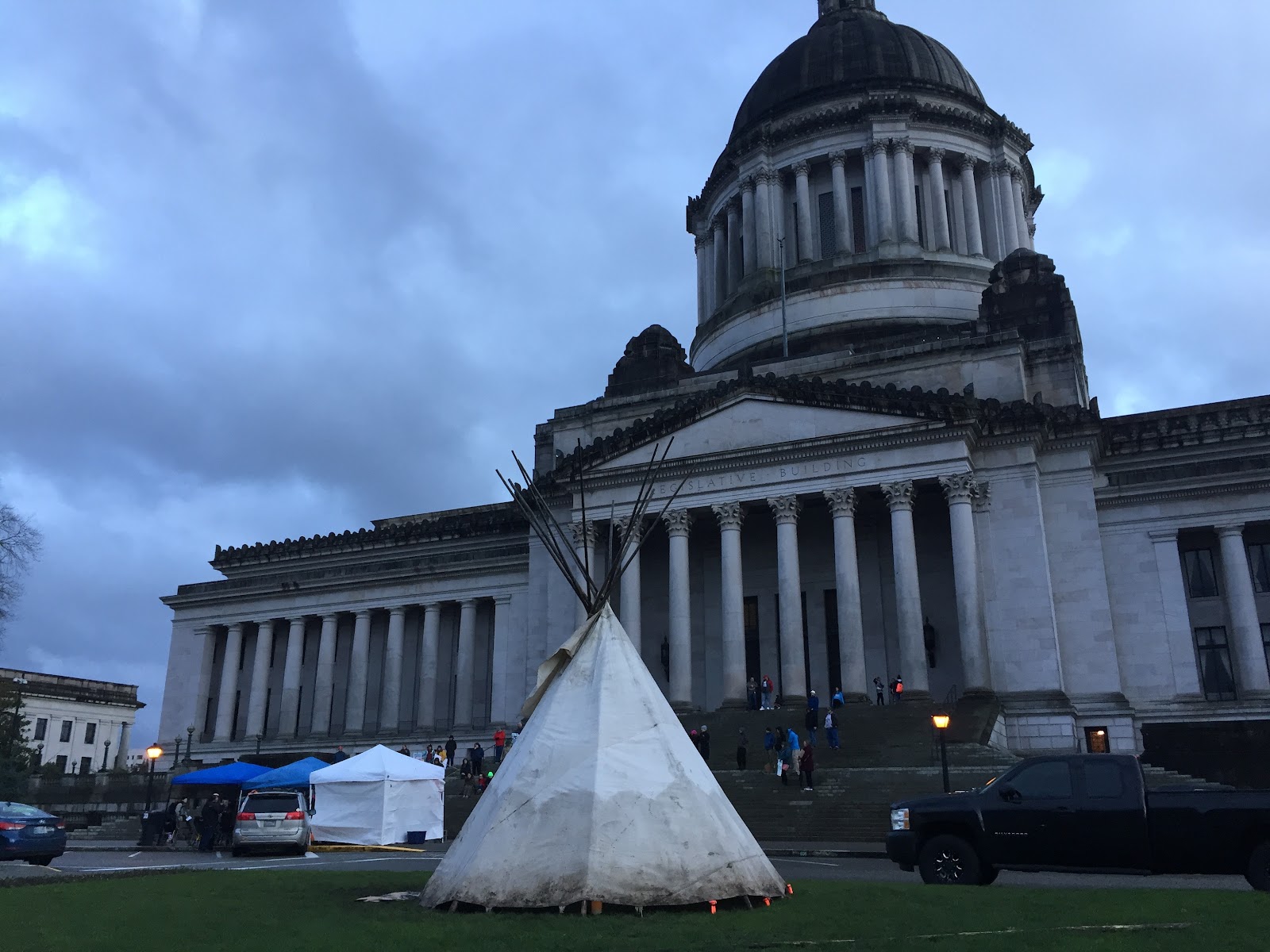
Description:
With dusk, the event is coming to a close, the crowd is dispersing, and clean up is happening. The Teepee rests in front of the huge legislative building, with its Western/Roman pillars of corinthean order, and huge domed top. The Teepee, especially at this place, like the event that just happened, is a symbol of Indigenous Resistance, Decolonization, Love. It is Work is Action, this is Hope.
Lisa Ganser is a white Disabled genderqueer artist and activist living in Olympia, WA on stolen and colonized Squaxin, Nisqually, Chehalis, First Nations land. They are a copwatcher, a sidewalk chalker and a dog walker, and the daughter of a momma named Sam.
